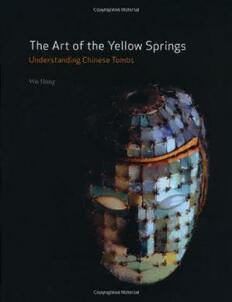
The art of the Yellow Springs : understanding Chinese tombs PDF
Preview The art of the Yellow Springs : understanding Chinese tombs
The Art of the Yellow Springs Understanding Chinese Tombs Wu Hung the art of the yellow springs The Art of the Yellow Springs Understanding Chinese Tombs Wu Hung reaktion books PublishedbyReaktionBooksLtd 33GreatSuttonStreet Londonec1v0dx,uk www.reaktionbooks.co.uk Firstpublished2010 Copyright©WuHung2010 Allrightsreserved Nopartofthispublicationmaybereproduced,storedinaretrievalsystem,ortransmitted, inanyformorbyanymeans,electronic,mechanical,photocopying,recordingorotherwise, withoutthepriorpermissionofthepublishers. PrintedandboundinChina byToppanPrintingCo.Ltd BritishLibraryCataloguinginPublicationData WuHung,1945– Theartoftheyellowsprings:understandingChinesetombs. 1.Art,Chinese–Appreciation. 2.Tombs–China. 3.Gravegoods–China. 4.Artobjects,Chinese. I.Title 709.5’1-dc22 isbn9781861896247 Contents Introduction 7 1 Spatiality 17 FromCasketGravetoChamberGrave 20 ATripartiteUniverse 34 RepresentingtheSoul 63 2 Materiality 85 SpiritArticles 87 TombFigurinesandtheMediumofRepresentation 99 TheBody:PreservationandTransformation 126 3 Temporality 149 Cosmic/MythicTime 151 ‘LivedObjects’ 163 HistoricalNarratives 173 Journey 192 Coda:PortrayingChineseTombs 219 References 234 WorksCited 255 Acknowledgements 263 Index 264 Introduction IntheancientChinesemind,theYellowSpringsrunningdeepbeneaththegroundboth nourishedlifeandinspiredfear.Thefirst-centurywriterBanGu(32–92ce)saysina philosophicaltreatise:‘TheyangetherrisesfromthedepthoftheYellowSpringsand benefitsallthelivingcreaturesintheuniverse.’1ButhiscontemporaryWangChong (27–97ce)complainedthat‘Noonelikestositaloneinaclosedchamberfacingdark- ness,nottomentionlyinginsideaholedugundergroundbesidetheYellowSprings.’2 Herethe‘undergroundhole’alludestoatomb,andinthiscontexttheYellowSprings referstothefinaldestinationofallmortalhumanbeingsafterdeath.AssuchtheYellow Springsevokedadifferentsortofambivalence,becausethiswastheplacewhereone wouldbereunitedwithlovedonesaswellasenemies.Ancienttextsofferexamplesfor bothviews.In721bce,forinstance,DukeZhuangofthestateofZhengsenthismother intoexileafterdiscoveringherschemetousurphisrule.Hislastwordstoherwereabit- ter oath: ‘We will never see each other again until we have both reached the Yellow Springs!’3Severalcenturieslater,duringtheJian’aneraoftheEasternHan(196–220ce), anothermotherforcedhersonJiaoZhongqing,aclerkworkinginthelocalgovernment atLujianginJiangxi,todivorcehiswife.Hersontriedtochangehismother’smindwith apleaabouthisunbendinglovetowardthewoman:‘We’vesharedpillowandmatfrom thetimewereachedadulthood,andwe’llgotogethertotheYellowSpringshandinhand.’4 Themotherwasunmoved,andthestoryendswiththecouple’sdoublesuicide. Astheseexamplessuggest,overthecourseofChinesehistory,theYellowSprings wastheimaginedlocationofinnumerablegravesconstructedoverseveralthousandsof years.(ThistermforthenetherworldwasalsoadoptedinJapaneseandKorean.)The word‘innumerable’issurelynotanexaggeration:theancientChinese(aswellasmany oftheirmodernandcontemporarycounterparts)heldtheconvictionthateveryone,even acriminal,deservedaburial;otherwisethedepartedsoulwouldturnintoaresentful, perniciousghosthauntingtheliving.Arudimentaryburialforaconvictcouldbelittle morethanashallowpit.Buta‘tomb’or‘grave’(muorfenmuinChinese)foracitizen usuallyimpliesaconstructedarchitecturalspacecontainingmortuarystructures,grave furnishingsandabove-groundlandmarks.Theoldestprescriptionandrationalizationof thisritualspaceappearsintwoancienttexts.Thefirst,MrLü’sSpringandAutumnAnnals (Lüshichunqiu),wascompletedin239bceunderLüBuwei.Apowerfulchancellorofthe Qin,Lühopedthatthebookwouldencompasstheknowledgeandwisdomofallmajor the art of the yellow springs 8 philosophicalschoolsinexistence.Thesecond,TheBookofRites(Liji),isaConfucian ritualcanonputtogetherintheearlyHan,butmanyofitschapterswerewritteninthe WarringStatesperiod,fromthefifthtothethirdcenturiesbce.Thepassagereads: Buryingmeanshidingaway;andthathiding[ofthecorpse]isfromawishthat menshouldnotseeit.Hencetherearetheclothessufficientforembellishing thebody;theguan-coffinallaroundtheclothes;theguo-casketallaroundthe guan-coffin;theearthallaroundtheguo-casket;andamoundfurtherraised overthatgravewithtreesplantedonit.5 This statement defines two essential characteristics of a traditional Chinese tomb.First,atombalwaysconsistsoftwospatial/architecturalcomplexes,oneabove groundandtheotherhiddenbeneaththesurfaceoftheearth.Itistemptingtothinkof theseasthe‘exterior’and‘interior’ofatomborgraveyard.Butinsteadofconstitutinga continuousarchitecturalprogramme,therelationshipbetweentheabove-groundand undergroundsectionsofatombischaracterizedbyanabruptspatialandperceptual discontinuity:thetwocomplexeshaveseparatephysicalenvironmentsandarchitectural designs,aswellasdifferentritualfunctionsandrelationshipswithpeople(illus.1).The ‘exterior’sectionofanelitetomb,oftenincludingatumulus,oneormoreritualbuild- ings,andstatuesandsteles,isexposedtoviewasthesiteofroutineritualperformances. The‘interior’section,oftenmorelavishlydecoratedandfurnished,concealsthebodyof thedeceasedandisrevealedonlythroughrobberyorarchaeologicalexcavation. Second, the fundamental purpose in constructing a tomb is to conceal the deceasedandtombfurnishingsfromhumaneyes.Thispurposeisrealizedthroughapro- longedritualprocess.Accordingtotraditionalritualprescriptions,afterapersondied, hisorherbodywouldbecarefullywashed,dressedandrituallyfed.Coffinsandobjects createdforaburialwouldbedisplayedpubliclyduringthefuneralpriortotheentomb- ment,andabriefceremonywouldsometimesbeperformedinsidetombchambersto allowthelivingtobidafinalfarewelltotheirdeceasedkin.6Butoncethegravewassealed noonewouldexploreitssecretagain.7 Themomentofentombmentthusmarksaradicalshiftintheidentityandmean- ingoftheundergroundchambersandtheircontents.Beforethismoment,theybelong tothisworldandaresubjecttothescrutinyofhumaneyes;afterwardstheybecomesolely 1Elevationofthe tombandshrineof ZhuWei.Jinxiang, Shandong.Eastern Han,2ndcenturyCE.
